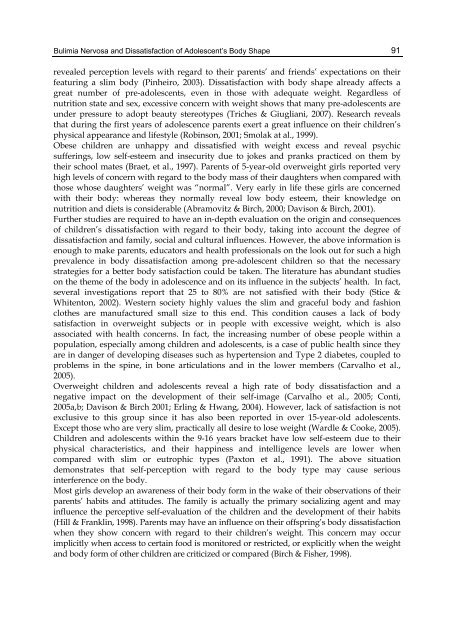new insights into the prevention and treatment of bulimia nervosa
new insights into the prevention and treatment of bulimia nervosa
new insights into the prevention and treatment of bulimia nervosa
Create successful ePaper yourself
Turn your PDF publications into a flip-book with our unique Google optimized e-Paper software.
Bulimia Nervosa <strong>and</strong> Dissatisfaction <strong>of</strong> Adolescent’s Body Shape<br />
revealed perception levels with regard to <strong>the</strong>ir parents’ <strong>and</strong> friends’ expectations on <strong>the</strong>ir<br />
featuring a slim body (Pinheiro, 2003). Dissatisfaction with body shape already affects a<br />
great number <strong>of</strong> pre-adolescents, even in those with adequate weight. Regardless <strong>of</strong><br />
nutrition state <strong>and</strong> sex, excessive concern with weight shows that many pre-adolescents are<br />
under pressure to adopt beauty stereotypes (Triches & Giugliani, 2007). Research reveals<br />
that during <strong>the</strong> first years <strong>of</strong> adolescence parents exert a great influence on <strong>the</strong>ir children’s<br />
physical appearance <strong>and</strong> lifestyle (Robinson, 2001; Smolak at al., 1999).<br />
Obese children are unhappy <strong>and</strong> dissatisfied with weight excess <strong>and</strong> reveal psychic<br />
sufferings, low self-esteem <strong>and</strong> insecurity due to jokes <strong>and</strong> pranks practiced on <strong>the</strong>m by<br />
<strong>the</strong>ir school mates (Braet, et al., 1997). Parents <strong>of</strong> 5-year-old overweight girls reported very<br />
high levels <strong>of</strong> concern with regard to <strong>the</strong> body mass <strong>of</strong> <strong>the</strong>ir daughters when compared with<br />
those whose daughters’ weight was “normal”. Very early in life <strong>the</strong>se girls are concerned<br />
with <strong>the</strong>ir body: whereas <strong>the</strong>y normally reveal low body esteem, <strong>the</strong>ir knowledge on<br />
nutrition <strong>and</strong> diets is considerable (Abramovitz & Birch, 2000; Davison & Birch, 2001).<br />
Fur<strong>the</strong>r studies are required to have an in-depth evaluation on <strong>the</strong> origin <strong>and</strong> consequences<br />
<strong>of</strong> children’s dissatisfaction with regard to <strong>the</strong>ir body, taking <strong>into</strong> account <strong>the</strong> degree <strong>of</strong><br />
dissatisfaction <strong>and</strong> family, social <strong>and</strong> cultural influences. However, <strong>the</strong> above information is<br />
enough to make parents, educators <strong>and</strong> health pr<strong>of</strong>essionals on <strong>the</strong> look out for such a high<br />
prevalence in body dissatisfaction among pre-adolescent children so that <strong>the</strong> necessary<br />
strategies for a better body satisfaction could be taken. The literature has abundant studies<br />
on <strong>the</strong> <strong>the</strong>me <strong>of</strong> <strong>the</strong> body in adolescence <strong>and</strong> on its influence in <strong>the</strong> subjects’ health. In fact,<br />
several investigations report that 25 to 80% are not satisfied with <strong>the</strong>ir body (Stice &<br />
Whitenton, 2002). Western society highly values <strong>the</strong> slim <strong>and</strong> graceful body <strong>and</strong> fashion<br />
clo<strong>the</strong>s are manufactured small size to this end. This condition causes a lack <strong>of</strong> body<br />
satisfaction in overweight subjects or in people with excessive weight, which is also<br />
associated with health concerns. In fact, <strong>the</strong> increasing number <strong>of</strong> obese people within a<br />
population, especially among children <strong>and</strong> adolescents, is a case <strong>of</strong> public health since <strong>the</strong>y<br />
are in danger <strong>of</strong> developing diseases such as hypertension <strong>and</strong> Type 2 diabetes, coupled to<br />
problems in <strong>the</strong> spine, in bone articulations <strong>and</strong> in <strong>the</strong> lower members (Carvalho et al.,<br />
2005).<br />
Overweight children <strong>and</strong> adolescents reveal a high rate <strong>of</strong> body dissatisfaction <strong>and</strong> a<br />
negative impact on <strong>the</strong> development <strong>of</strong> <strong>the</strong>ir self-image (Carvalho et al., 2005; Conti,<br />
2005a,b; Davison & Birch 2001; Erling & Hwang, 2004). However, lack <strong>of</strong> satisfaction is not<br />
exclusive to this group since it has also been reported in over 15-year-old adolescents.<br />
Except those who are very slim, practically all desire to lose weight (Wardle & Cooke, 2005).<br />
Children <strong>and</strong> adolescents within <strong>the</strong> 9-16 years bracket have low self-esteem due to <strong>the</strong>ir<br />
physical characteristics, <strong>and</strong> <strong>the</strong>ir happiness <strong>and</strong> intelligence levels are lower when<br />
compared with slim or eutrophic types (Paxton et al., 1991). The above situation<br />
demonstrates that self-perception with regard to <strong>the</strong> body type may cause serious<br />
interference on <strong>the</strong> body.<br />
Most girls develop an awareness <strong>of</strong> <strong>the</strong>ir body form in <strong>the</strong> wake <strong>of</strong> <strong>the</strong>ir observations <strong>of</strong> <strong>the</strong>ir<br />
parents’ habits <strong>and</strong> attitudes. The family is actually <strong>the</strong> primary socializing agent <strong>and</strong> may<br />
influence <strong>the</strong> perceptive self-evaluation <strong>of</strong> <strong>the</strong> children <strong>and</strong> <strong>the</strong> development <strong>of</strong> <strong>the</strong>ir habits<br />
(Hill & Franklin, 1998). Parents may have an influence on <strong>the</strong>ir <strong>of</strong>fspring’s body dissatisfaction<br />
when <strong>the</strong>y show concern with regard to <strong>the</strong>ir children’s weight. This concern may occur<br />
implicitly when access to certain food is monitored or restricted, or explicitly when <strong>the</strong> weight<br />
<strong>and</strong> body form <strong>of</strong> o<strong>the</strong>r children are criticized or compared (Birch & Fisher, 1998).<br />
91














![focuspdca.ppt [Compatibility Mode]](https://img.yumpu.com/22859457/1/190x146/focuspdcappt-compatibility-mode.jpg?quality=85)


